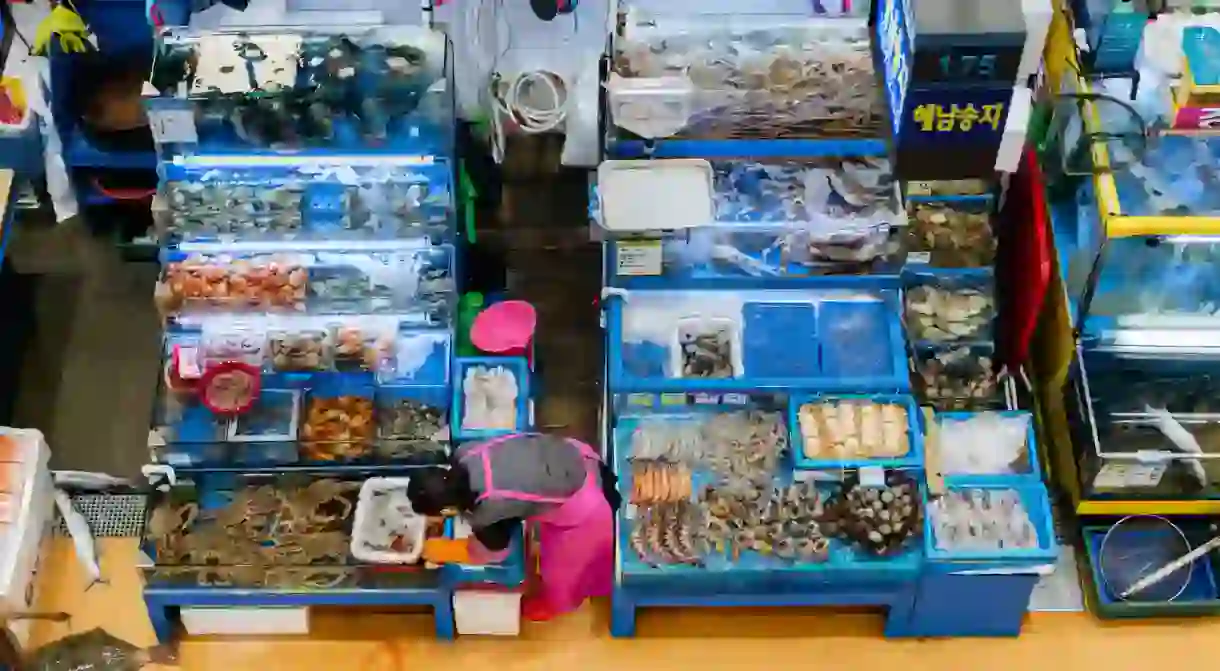A Complete Guide to Seoul's Noryangjin Fish Market

Along with eating Korean barbecue, joining a noraebang (karaoke) session and stripping down in a public sauna, visiting the Noryangjin Fish Market is a highlight on any trip for getting to know Seoul’s culture. But those unaccustomed to the market atmosphere often avoid it, intimidated by the language barrier. Follow our advice and you can easily explore this fish market for a perfect day in the capital of South Korea and eat the freshest seafood in town.
What to wear
Market, Seafood
What to wear
Noryangjin is not a nicely organised farmer’s market. It’s a lively, chaotic and very wet fish market. Leave your fancy clothes and luxury bags at home. Rather, opt to wear closed-toe shoes or boots that can stand up to puddles of fishy (and often frigid) water.

The fun begins
As hectic as things may feel, there’s no need to rush your way through the market. Let your senses be aroused by the sights, sounds and smells as you wander from vendor to vendor. Feel free to snap photos of the weird and wonderful sea creatures on display, many of which you’ll probably be seeing for the first time. (Don’t miss the penis fish!)


Pick your catch
Koreans generally visit Noryangjin to purchase fresh hwe, sliced raw fish. Even those who know nothing about seafood will find the selection process fairly easy, as vendors are more than willing to help shoppers select their catch. Vendors will then weigh the fish and quote a price, most often using a calculator if they sense you might not know Korean.


Expected prices
While some seafood like king crab and abalone can get quite pricey, many items are fairly affordable. A couple of small octopuses should run you about ₩10,000 (£6.50) and a substantial fillet of salmon shouldn’t be more than ₩25,000 won (£16), depending on the size and your bargaining skills.

Bargain away
Negotiating is acceptable – if not expected – at Noryangjin. In fact, vendors will often pitch the opening price a bit higher than what it should be, anticipating a lower counter-offer. After some bargaining, if the price still seems too high, walk away. Nevertheless, you should keep in mind that some seafood does command a premium price, and will still be great value compared to what you’d pay at a restaurant.

In general, vendors are more willing to negotiate if you’re buying in larger quantities. Or, rather than lowering their price, they might offer you some freebies – what Koreans refer to as service – such as a few extra shrimp or a couple of oysters.

Get your grub on
After you’ve made your purchases, you have the option of having them prepared for you on-site at one of the restaurants on the second floor and basement levels. Don’t worry about tracking one of them down, however, as their representatives will often find you first. Hand over your catch, which they will bring to the restaurant for you.

If you prefer your fish sashimi-style, the server will gut, skin and slice up your purchase right before your eyes, serving it with pickled onion, raw wasabi, green chilli, fermented bean paste for dipping and lettuce leaves to wrap it all up with. Should an item need cooking, the in-house chef will do so. Shrimp are usually grilled in their shells, while crabs are boiled.

Meal add-ons
If you’re eating crab, ask for bokkeumbap, tasty fried rice, which is served in the crab’s shell. Or, if you’ve purchased fish, order maeuntang at the beginning of your meal. This delightfully spicy dish is cooked with fish bones for added flavour and traditionally finishes a seafood spread.

Of course, no Noryangjin meal would be complete without a bit of soju, so order a bottle or two to drink on its own, or mix in with a few maekju (beers) – a Korean cocktail appropriately named somaek.
Adventurous eating
Feeling bold? Do as the adventurous eaters do and order a plate of sannakji, live octopus. It’s served chopped up (but still wriggling around) and with a selection of dipping sauces. Just be sure to have your camera ready. This is one Noryangjin moment you won’t want to forget.

Settling the bill
While you will need to pay the restaurant separately from the fish sellers, there’s no need to fret; the service charge is very reasonable.

When to go
Anytime is best time to visit Noryangjin Fish Market. The market is open 24/7, but if you want to witness the famous fish auctions, you’ll have to visit around 3am. Otherwise, the market vendors and restaurants are open daily and are busiest on the weekends.

Getting there
Getting to Noryangjin is easy, when you know where you’re going. Take the Seoul subway to Noryangjin Station (Lines 1 and 9). From exit 1, walk about 100m (330ft) over the train tracks via the footbridge, following the English signage. Go down the stairs to get to the trading floor of the market.













